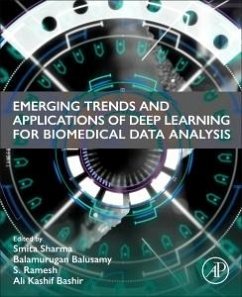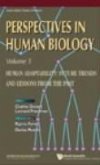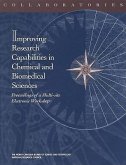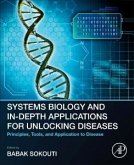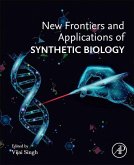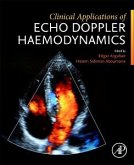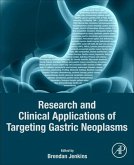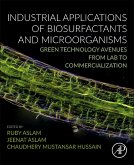Emerging Trends and Applications of Deep Learning for Biomedical Data Analysis
Herausgeber: Sharma, Smita; Bashir, Ali Kashif; Ramesh, S.; Balusamy, Balamurugan
Emerging Trends and Applications of Deep Learning for Biomedical Data Analysis
Herausgeber: Sharma, Smita; Bashir, Ali Kashif; Ramesh, S.; Balusamy, Balamurugan
- Broschiertes Buch
- Merkliste
- Auf die Merkliste
- Bewerten Bewerten
- Teilen
- Produkt teilen
- Produkterinnerung
- Produkterinnerung
Emerging Trends and Applications of Deep Learning for Biomedical Data Analysis introduces the latest emerging trends and applications of deep learning in biomedical data analysis. This book delves into various use cases where deep learning is applied in industrial, social, and personal contexts within the biomedical domain. By gaining a comprehensive understanding of deep learning in biomedical data analysis, readers will develop the skills to critically evaluate research papers, methodologies, and emerging trends. In 11 chapters, this book provides insights into the fundamentals of the latest…mehr
Andere Kunden interessierten sich auch für
![Human Adaptability: Future Trends and Lessons from the Past, Perspective in Human Biology, Vol 3 Human Adaptability: Future Trends and Lessons from the Past, Perspective in Human Biology, Vol 3]() Human Adaptability: Future Trends and Lessons from the Past, Perspective in Human Biology, Vol 327,99 €
Human Adaptability: Future Trends and Lessons from the Past, Perspective in Human Biology, Vol 327,99 €![Collaboratories: Improving Research Capabilities in Chemical and Biomedical Sciences Collaboratories: Improving Research Capabilities in Chemical and Biomedical Sciences]() North Carolina Board of Science and Technology and National Research CouncilCollaboratories: Improving Research Capabilities in Chemical and Biomedical Sciences40,99 €
North Carolina Board of Science and Technology and National Research CouncilCollaboratories: Improving Research Capabilities in Chemical and Biomedical Sciences40,99 €![Systems Biology and In-Depth Applications for Unlocking Diseases Systems Biology and In-Depth Applications for Unlocking Diseases]() Systems Biology and In-Depth Applications for Unlocking Diseases156,99 €
Systems Biology and In-Depth Applications for Unlocking Diseases156,99 €![New Frontiers and Applications of Synthetic Biology New Frontiers and Applications of Synthetic Biology]() New Frontiers and Applications of Synthetic Biology178,99 €
New Frontiers and Applications of Synthetic Biology178,99 €![Clinical Applications of Echo Doppler Haemodynamics Clinical Applications of Echo Doppler Haemodynamics]() Clinical Applications of Echo Doppler Haemodynamics156,99 €
Clinical Applications of Echo Doppler Haemodynamics156,99 €![Research and Clinical Applications of Targeting Gastric Neoplasms Research and Clinical Applications of Targeting Gastric Neoplasms]() Research and Clinical Applications of Targeting Gastric Neoplasms147,99 €
Research and Clinical Applications of Targeting Gastric Neoplasms147,99 €![Industrial Applications of Biosurfactants and Microorganisms Industrial Applications of Biosurfactants and Microorganisms]() Industrial Applications of Biosurfactants and Microorganisms156,99 €
Industrial Applications of Biosurfactants and Microorganisms156,99 €-
-
-
Emerging Trends and Applications of Deep Learning for Biomedical Data Analysis introduces the latest emerging trends and applications of deep learning in biomedical data analysis. This book delves into various use cases where deep learning is applied in industrial, social, and personal contexts within the biomedical domain. By gaining a comprehensive understanding of deep learning in biomedical data analysis, readers will develop the skills to critically evaluate research papers, methodologies, and emerging trends. In 11 chapters, this book provides insights into the fundamentals of the latest research trends in the applications of deep learning in biosciences. With several case studies and use cases, it familiarizes the reader with a comprehensive understanding of deep learning algorithms, architectures, and methodologies speci cally applicable to biomedical data analysis. This title is an ideal reference for researchers across the biomedical sciences.
Produktdetails
- Produktdetails
- Verlag: Elsevier Science
- Seitenzahl: 232
- Erscheinungstermin: 18. Juni 2025
- Englisch
- Abmessung: 228mm x 161mm x 12mm
- Gewicht: 386g
- ISBN-13: 9780443267659
- ISBN-10: 0443267650
- Artikelnr.: 71302887
- Herstellerkennzeichnung
- Libri GmbH
- Europaallee 1
- 36244 Bad Hersfeld
- gpsr@libri.de
- Verlag: Elsevier Science
- Seitenzahl: 232
- Erscheinungstermin: 18. Juni 2025
- Englisch
- Abmessung: 228mm x 161mm x 12mm
- Gewicht: 386g
- ISBN-13: 9780443267659
- ISBN-10: 0443267650
- Artikelnr.: 71302887
- Herstellerkennzeichnung
- Libri GmbH
- Europaallee 1
- 36244 Bad Hersfeld
- gpsr@libri.de
1. Deep learning, artificial intelligence, and bioinformatics promises
innovations and imminent forecasts in SARS-COVID-19 genome data analysis
S. Sheik Asraf, P. Nagaraj, and V. Muneeswaran
1.1 Introduction
1.2 COVID-19-a global pandemic
1.3 Genomics of COVID-19
1.4 Applications of deep learning in COVID-19 genomics studies
1.5 Role of artificial intelligence in COVID-19 genomics research
1.6 Usage of bioinformatics tools, software, and databases in COVID-19
genomics investigation
1.7 Challenges and prospects of deep learning, artificial intelligence, and
bioinformatics in COVID-19 genomics
1.8 Conclusion
References
2. Integration of IoT and AI for potato leaf disease detection: enhancing
agricultural efficiency and sustainability
E. Senthamil Selvi and S. Anusuya
2.1 Introduction
2.2 Literature survey
2.3 Classification process for potato leaf diseases
2.4 Image preliminary processing
2.5 Image augmentation
2.6 Feature extraction
2.7 Evaluation and recognition
2.8 Methods and materials
2.9 Transfer learning
2.10 Pretrained network model
2.11 Proposed model
2.12 Result and discussion
2.13 Conclusion
2.14 Future work
References
3. A hybridized long-short-term memory networks-based deep learning model
using reptile search optimization for COVID-19 prediction
Balakrishnama Manohar, Raja Das, Potharla Ramadevi, and Balamurugan
Balusamy
3.1 Introduction
3.2 Materials and methods
3.3 Data preprocessing
3.4 Data normalization
3.5 Proposed methodology
3.6 Methodology
3.7 Reptile search algorithm
3.8 Encircling phase (global search or exploration)
3.9 Hunting phase (local search or exploitation)
3.10 Optimized long-short-term memory networks-reptile search algorithm
model
3.11 Model evaluation
3.12 Results
3.13 Conclusion
References
4. Improving coronavirus classification accuracy with transfer learning and
chest radiograph analysis
M. Lakshmi, Raja Das, Balakrishnama Manohar, and Balamurugan Balusamy
4.1 Introduction
4.2 Related works
4.3 Materials and methods
4.4 Results and discussion
4.5 Conclusion
References
5. A hybrid deep neural network using the Levenberg-Marquardt algorithm
applied to the nonlinear magnetohydrodynamic Jeffery-Hamel blood flow
problem
Priyanka Chandra, Raja Das, and Smita Sharma
5.1 Introduction
5.2 Mathematical modeling
5.3 Solution methodology
5.4 Result and discussion
5.5 Conclusion
Ethical statement
Acknowledgment
Declaration of interest statement
Funding
Data availability statement
References
6. An image segmentation method using intuitionistic fuzzy k-means and
convolutional neural networks in multiclass image classification
Potharla Ramadevi, Raja Das, M. Lakshmi, Balakrishnama Manohar, and Smita
Sharma
6.1 Introduction
6.2 Related works
6.3 Methodology
6.4 Results and discussion
6.5 Conclusion
References
7. Deep learning for wearable sensor data analysis
P. Aakash Kumar, Abha Rani, S. Amutha, and B. Surendiran
7.1 Introduction
7.2 Literature review
7.3 Methodology
7.4 Result and discussion
7.5 Conclusion
References
8. Unveiling emotions in real-time: a novel approach to face emotion
recognition
Gowthami V. and Vijayalakshmi R.
8.1 Introduction
8.2 Convolutional neural network
8.3 Objective
8.4 Literature survey
8.5 Proposed work
8.6 Pseudocode for training the model
8.7 Results
8.8 Future work
References
Further reading
9. Unleashing the power of convolutional neural networks for diabetic
retinopathy detection in ophthalmology
Gowthami V. and K. Alamelu
9.1 Introduction
9.2 Literature review
9.3 System methodology
9.4 Result and discussion
9.5 Conclusion and future work
References
10. Case studies and use cases of deep learning for biomedical applications
Amutha Prabakar Muniyandi, Padmavathy T., and Balamurugan Balusamy
10.1 Introduction
10.2 Impact of deep learning in bio-engineering
10.3 Evolution of artificial neural networks
10.4 Applications of deep learning-bioinformatics
10.5 Explainable artificial intelligence in bioinformatics
10.6 Conclusion
References
11. A convolutional neural network-based deep ensemble method for computed
tomography scan image-based lung cancer diagnosis
R. Jothi, Shravani Swaroop Urala, and K. Muthukumaran
11.1 Introduction
11.2 Related work
11.3 Dataset
11.4 Methodology
11.5 Experimental results and discussion
11.6 Conclusion
References
Index
innovations and imminent forecasts in SARS-COVID-19 genome data analysis
S. Sheik Asraf, P. Nagaraj, and V. Muneeswaran
1.1 Introduction
1.2 COVID-19-a global pandemic
1.3 Genomics of COVID-19
1.4 Applications of deep learning in COVID-19 genomics studies
1.5 Role of artificial intelligence in COVID-19 genomics research
1.6 Usage of bioinformatics tools, software, and databases in COVID-19
genomics investigation
1.7 Challenges and prospects of deep learning, artificial intelligence, and
bioinformatics in COVID-19 genomics
1.8 Conclusion
References
2. Integration of IoT and AI for potato leaf disease detection: enhancing
agricultural efficiency and sustainability
E. Senthamil Selvi and S. Anusuya
2.1 Introduction
2.2 Literature survey
2.3 Classification process for potato leaf diseases
2.4 Image preliminary processing
2.5 Image augmentation
2.6 Feature extraction
2.7 Evaluation and recognition
2.8 Methods and materials
2.9 Transfer learning
2.10 Pretrained network model
2.11 Proposed model
2.12 Result and discussion
2.13 Conclusion
2.14 Future work
References
3. A hybridized long-short-term memory networks-based deep learning model
using reptile search optimization for COVID-19 prediction
Balakrishnama Manohar, Raja Das, Potharla Ramadevi, and Balamurugan
Balusamy
3.1 Introduction
3.2 Materials and methods
3.3 Data preprocessing
3.4 Data normalization
3.5 Proposed methodology
3.6 Methodology
3.7 Reptile search algorithm
3.8 Encircling phase (global search or exploration)
3.9 Hunting phase (local search or exploitation)
3.10 Optimized long-short-term memory networks-reptile search algorithm
model
3.11 Model evaluation
3.12 Results
3.13 Conclusion
References
4. Improving coronavirus classification accuracy with transfer learning and
chest radiograph analysis
M. Lakshmi, Raja Das, Balakrishnama Manohar, and Balamurugan Balusamy
4.1 Introduction
4.2 Related works
4.3 Materials and methods
4.4 Results and discussion
4.5 Conclusion
References
5. A hybrid deep neural network using the Levenberg-Marquardt algorithm
applied to the nonlinear magnetohydrodynamic Jeffery-Hamel blood flow
problem
Priyanka Chandra, Raja Das, and Smita Sharma
5.1 Introduction
5.2 Mathematical modeling
5.3 Solution methodology
5.4 Result and discussion
5.5 Conclusion
Ethical statement
Acknowledgment
Declaration of interest statement
Funding
Data availability statement
References
6. An image segmentation method using intuitionistic fuzzy k-means and
convolutional neural networks in multiclass image classification
Potharla Ramadevi, Raja Das, M. Lakshmi, Balakrishnama Manohar, and Smita
Sharma
6.1 Introduction
6.2 Related works
6.3 Methodology
6.4 Results and discussion
6.5 Conclusion
References
7. Deep learning for wearable sensor data analysis
P. Aakash Kumar, Abha Rani, S. Amutha, and B. Surendiran
7.1 Introduction
7.2 Literature review
7.3 Methodology
7.4 Result and discussion
7.5 Conclusion
References
8. Unveiling emotions in real-time: a novel approach to face emotion
recognition
Gowthami V. and Vijayalakshmi R.
8.1 Introduction
8.2 Convolutional neural network
8.3 Objective
8.4 Literature survey
8.5 Proposed work
8.6 Pseudocode for training the model
8.7 Results
8.8 Future work
References
Further reading
9. Unleashing the power of convolutional neural networks for diabetic
retinopathy detection in ophthalmology
Gowthami V. and K. Alamelu
9.1 Introduction
9.2 Literature review
9.3 System methodology
9.4 Result and discussion
9.5 Conclusion and future work
References
10. Case studies and use cases of deep learning for biomedical applications
Amutha Prabakar Muniyandi, Padmavathy T., and Balamurugan Balusamy
10.1 Introduction
10.2 Impact of deep learning in bio-engineering
10.3 Evolution of artificial neural networks
10.4 Applications of deep learning-bioinformatics
10.5 Explainable artificial intelligence in bioinformatics
10.6 Conclusion
References
11. A convolutional neural network-based deep ensemble method for computed
tomography scan image-based lung cancer diagnosis
R. Jothi, Shravani Swaroop Urala, and K. Muthukumaran
11.1 Introduction
11.2 Related work
11.3 Dataset
11.4 Methodology
11.5 Experimental results and discussion
11.6 Conclusion
References
Index
1. Deep learning, artificial intelligence, and bioinformatics promises
innovations and imminent forecasts in SARS-COVID-19 genome data analysis
S. Sheik Asraf, P. Nagaraj, and V. Muneeswaran
1.1 Introduction
1.2 COVID-19-a global pandemic
1.3 Genomics of COVID-19
1.4 Applications of deep learning in COVID-19 genomics studies
1.5 Role of artificial intelligence in COVID-19 genomics research
1.6 Usage of bioinformatics tools, software, and databases in COVID-19
genomics investigation
1.7 Challenges and prospects of deep learning, artificial intelligence, and
bioinformatics in COVID-19 genomics
1.8 Conclusion
References
2. Integration of IoT and AI for potato leaf disease detection: enhancing
agricultural efficiency and sustainability
E. Senthamil Selvi and S. Anusuya
2.1 Introduction
2.2 Literature survey
2.3 Classification process for potato leaf diseases
2.4 Image preliminary processing
2.5 Image augmentation
2.6 Feature extraction
2.7 Evaluation and recognition
2.8 Methods and materials
2.9 Transfer learning
2.10 Pretrained network model
2.11 Proposed model
2.12 Result and discussion
2.13 Conclusion
2.14 Future work
References
3. A hybridized long-short-term memory networks-based deep learning model
using reptile search optimization for COVID-19 prediction
Balakrishnama Manohar, Raja Das, Potharla Ramadevi, and Balamurugan
Balusamy
3.1 Introduction
3.2 Materials and methods
3.3 Data preprocessing
3.4 Data normalization
3.5 Proposed methodology
3.6 Methodology
3.7 Reptile search algorithm
3.8 Encircling phase (global search or exploration)
3.9 Hunting phase (local search or exploitation)
3.10 Optimized long-short-term memory networks-reptile search algorithm
model
3.11 Model evaluation
3.12 Results
3.13 Conclusion
References
4. Improving coronavirus classification accuracy with transfer learning and
chest radiograph analysis
M. Lakshmi, Raja Das, Balakrishnama Manohar, and Balamurugan Balusamy
4.1 Introduction
4.2 Related works
4.3 Materials and methods
4.4 Results and discussion
4.5 Conclusion
References
5. A hybrid deep neural network using the Levenberg-Marquardt algorithm
applied to the nonlinear magnetohydrodynamic Jeffery-Hamel blood flow
problem
Priyanka Chandra, Raja Das, and Smita Sharma
5.1 Introduction
5.2 Mathematical modeling
5.3 Solution methodology
5.4 Result and discussion
5.5 Conclusion
Ethical statement
Acknowledgment
Declaration of interest statement
Funding
Data availability statement
References
6. An image segmentation method using intuitionistic fuzzy k-means and
convolutional neural networks in multiclass image classification
Potharla Ramadevi, Raja Das, M. Lakshmi, Balakrishnama Manohar, and Smita
Sharma
6.1 Introduction
6.2 Related works
6.3 Methodology
6.4 Results and discussion
6.5 Conclusion
References
7. Deep learning for wearable sensor data analysis
P. Aakash Kumar, Abha Rani, S. Amutha, and B. Surendiran
7.1 Introduction
7.2 Literature review
7.3 Methodology
7.4 Result and discussion
7.5 Conclusion
References
8. Unveiling emotions in real-time: a novel approach to face emotion
recognition
Gowthami V. and Vijayalakshmi R.
8.1 Introduction
8.2 Convolutional neural network
8.3 Objective
8.4 Literature survey
8.5 Proposed work
8.6 Pseudocode for training the model
8.7 Results
8.8 Future work
References
Further reading
9. Unleashing the power of convolutional neural networks for diabetic
retinopathy detection in ophthalmology
Gowthami V. and K. Alamelu
9.1 Introduction
9.2 Literature review
9.3 System methodology
9.4 Result and discussion
9.5 Conclusion and future work
References
10. Case studies and use cases of deep learning for biomedical applications
Amutha Prabakar Muniyandi, Padmavathy T., and Balamurugan Balusamy
10.1 Introduction
10.2 Impact of deep learning in bio-engineering
10.3 Evolution of artificial neural networks
10.4 Applications of deep learning-bioinformatics
10.5 Explainable artificial intelligence in bioinformatics
10.6 Conclusion
References
11. A convolutional neural network-based deep ensemble method for computed
tomography scan image-based lung cancer diagnosis
R. Jothi, Shravani Swaroop Urala, and K. Muthukumaran
11.1 Introduction
11.2 Related work
11.3 Dataset
11.4 Methodology
11.5 Experimental results and discussion
11.6 Conclusion
References
Index
innovations and imminent forecasts in SARS-COVID-19 genome data analysis
S. Sheik Asraf, P. Nagaraj, and V. Muneeswaran
1.1 Introduction
1.2 COVID-19-a global pandemic
1.3 Genomics of COVID-19
1.4 Applications of deep learning in COVID-19 genomics studies
1.5 Role of artificial intelligence in COVID-19 genomics research
1.6 Usage of bioinformatics tools, software, and databases in COVID-19
genomics investigation
1.7 Challenges and prospects of deep learning, artificial intelligence, and
bioinformatics in COVID-19 genomics
1.8 Conclusion
References
2. Integration of IoT and AI for potato leaf disease detection: enhancing
agricultural efficiency and sustainability
E. Senthamil Selvi and S. Anusuya
2.1 Introduction
2.2 Literature survey
2.3 Classification process for potato leaf diseases
2.4 Image preliminary processing
2.5 Image augmentation
2.6 Feature extraction
2.7 Evaluation and recognition
2.8 Methods and materials
2.9 Transfer learning
2.10 Pretrained network model
2.11 Proposed model
2.12 Result and discussion
2.13 Conclusion
2.14 Future work
References
3. A hybridized long-short-term memory networks-based deep learning model
using reptile search optimization for COVID-19 prediction
Balakrishnama Manohar, Raja Das, Potharla Ramadevi, and Balamurugan
Balusamy
3.1 Introduction
3.2 Materials and methods
3.3 Data preprocessing
3.4 Data normalization
3.5 Proposed methodology
3.6 Methodology
3.7 Reptile search algorithm
3.8 Encircling phase (global search or exploration)
3.9 Hunting phase (local search or exploitation)
3.10 Optimized long-short-term memory networks-reptile search algorithm
model
3.11 Model evaluation
3.12 Results
3.13 Conclusion
References
4. Improving coronavirus classification accuracy with transfer learning and
chest radiograph analysis
M. Lakshmi, Raja Das, Balakrishnama Manohar, and Balamurugan Balusamy
4.1 Introduction
4.2 Related works
4.3 Materials and methods
4.4 Results and discussion
4.5 Conclusion
References
5. A hybrid deep neural network using the Levenberg-Marquardt algorithm
applied to the nonlinear magnetohydrodynamic Jeffery-Hamel blood flow
problem
Priyanka Chandra, Raja Das, and Smita Sharma
5.1 Introduction
5.2 Mathematical modeling
5.3 Solution methodology
5.4 Result and discussion
5.5 Conclusion
Ethical statement
Acknowledgment
Declaration of interest statement
Funding
Data availability statement
References
6. An image segmentation method using intuitionistic fuzzy k-means and
convolutional neural networks in multiclass image classification
Potharla Ramadevi, Raja Das, M. Lakshmi, Balakrishnama Manohar, and Smita
Sharma
6.1 Introduction
6.2 Related works
6.3 Methodology
6.4 Results and discussion
6.5 Conclusion
References
7. Deep learning for wearable sensor data analysis
P. Aakash Kumar, Abha Rani, S. Amutha, and B. Surendiran
7.1 Introduction
7.2 Literature review
7.3 Methodology
7.4 Result and discussion
7.5 Conclusion
References
8. Unveiling emotions in real-time: a novel approach to face emotion
recognition
Gowthami V. and Vijayalakshmi R.
8.1 Introduction
8.2 Convolutional neural network
8.3 Objective
8.4 Literature survey
8.5 Proposed work
8.6 Pseudocode for training the model
8.7 Results
8.8 Future work
References
Further reading
9. Unleashing the power of convolutional neural networks for diabetic
retinopathy detection in ophthalmology
Gowthami V. and K. Alamelu
9.1 Introduction
9.2 Literature review
9.3 System methodology
9.4 Result and discussion
9.5 Conclusion and future work
References
10. Case studies and use cases of deep learning for biomedical applications
Amutha Prabakar Muniyandi, Padmavathy T., and Balamurugan Balusamy
10.1 Introduction
10.2 Impact of deep learning in bio-engineering
10.3 Evolution of artificial neural networks
10.4 Applications of deep learning-bioinformatics
10.5 Explainable artificial intelligence in bioinformatics
10.6 Conclusion
References
11. A convolutional neural network-based deep ensemble method for computed
tomography scan image-based lung cancer diagnosis
R. Jothi, Shravani Swaroop Urala, and K. Muthukumaran
11.1 Introduction
11.2 Related work
11.3 Dataset
11.4 Methodology
11.5 Experimental results and discussion
11.6 Conclusion
References
Index

